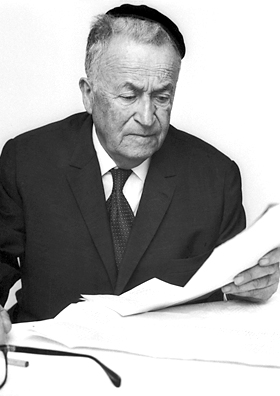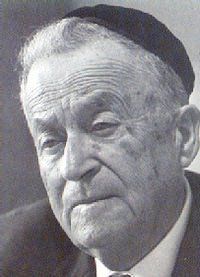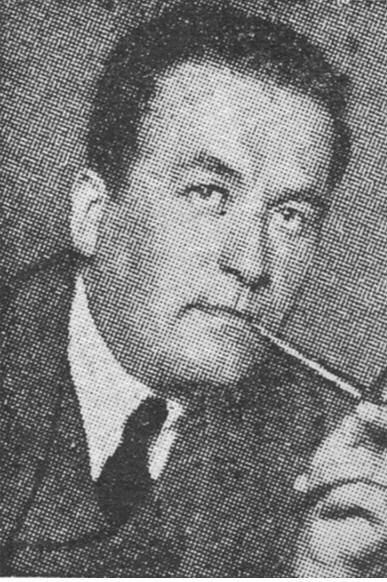<Back to Index>
- Businessman Johann Jakob Astor, 1763
- Writer Shmuel Yosef Agnon, 1888
- People's Commissar for Foreign Affairs Maxim Maximovich Litvinov, 1876
PAGE SPONSOR



Shmuel Yosef Agnon (Hebrew: שמואל יוסף עגנון), (July 17, 1888 – February 17, 1970) was a Nobel Prize laureate writer and was one of the central figures of modern Hebrew fiction. In Hebrew, he is known by the acronym Shai Agnon (ש"י עגנון). In English, his works are published under the name S.Y. Agnon.
Agnon was born in Galicia, Austro - Hungarian Empire (today Ukraine), later immigrated to the British mandate of Palestine, and died in Jerusalem. His works deal with the conflict between the traditional Jewish life and language and the modern world. They also attempt to recapture the fading traditions of the European shtetl (village). In a wider context, he also contributed to broadening the characteristic conception of the narrator's role in literature. Agnon shared the Nobel Prize with the poet Nelly Sachs in 1966.
Agnon was born Shmuel Yosef Halevi Czaczkes in Buczacz (Polish spelling, pronounced Buchach) or Butschatsch (German spelling), Galicia (then within the Austro - Hungarian Empire), now Buchach, Ukraine. Officially, his date of birth on the Hebrew calendar was 18 Av 5648 (July 26), but he always said his birthday was on the Jewish fast day of Tisha B'Av, the Ninth of Av. His father, Shalom Mordechai Halevy, was ordained as a rabbi, but worked in the fur trade, and had many connections among the Hasidim. His mother's side had ties to the Mitnagdim. He did not attend school and was schooled by his parents. In addition to studying Jewish texts, Agnon studied writings of the Haskalah, and was even tutored in German. At the age of eight, he began to write in Hebrew and Yiddish. At the age of 15, he published his first poem - a Yiddish poem about the Kabbalist Joseph della Reina. He continued to write poems and stories in Hebrew and Yiddish, which were published in Galicia.
In 1908, he immigrated to Jaffa. The first story he published there was "Agunot" ("Forsaken Wives"), which appeared that same year in the journal Ha`omer. He used the pen name "Agnon," derived from the title of the story, which he adopted as his official surname in 1924. In 1910, "Forsaken Wives" was translated into German. In 1912, at the urging of Yosef Haim Brenner, he published a novella, "Vehaya Ha'akov Lemishor" ("And the Crooked Shall Be Made Straight"). In 1913, Agnon moved to Germany, where he met Esther Marx. They married in 1920 and had two children. In Germany he lived in Berlin and Bad Homburg vor der Höhe (1921 – 24). Salman Schocken, a businessman and later also publisher, became his literary patron and freed him from financial worries. From 1931 on, his work was published by Schocken Books, and his short stories appeared regularly in the newspaper Haaretz, also owned by the Schocken family. In Germany, he continued to write short stories and collaborated with Martin Buber on an anthology of Hasidic stories. Many of his early books appeared in Buber's Jüdischer Verlag (Berlin). The mostly assimilated, secular German Jews, Buber and Franz Rosenzweig among them, considered Agnon to be a legitimate relic, being a religious man, familiar with Jewish scripture. Gershom Sholem called him "the Jews' Jew". In
1924, a fire broke out in his home, destroying his manuscripts and rare
book collection. This traumatic event crops up occasionally in his
stories. Later that year, Agnon returned to Jerusalem and settled with his family in the neighborhood of Talpiot. In 1929, his library was destroyed again during anti - Jewish riots. When his novel Hachnasat Kalla ("The Bridal Canopy") appeared in 1931 to great critical acclaim, Agnon's place in Hebrew literature was assured. In 1935, he published "Sippur Pashut" ("A Simple Story"), a novella set in Buczacz at the end of the 19th century. Another novel, "Tmol Shilshom" ("Yesteryear"), set in Eretz Yisrael of the early 20th century, appeared in 1945. Agnon's writing has been the subject of extensive academic research. Many leading scholars of Hebrew literature have published books and papers on his work, among them Baruch Kurzweil, Dov Sadan, Nitza Ben-Dov, Dan Miron, and Dan Laor.
Agnon writes about Jewish life, but with his own unique perspective and
special touch. In his Nobel acceptance speech, Agnon claimed "Some see
in my books the influences of authors whose names, in my ignorance, I
have not even heard, while others see the influences of poets whose
names I have heard but whose writings I have not read." He went on to
detail that his primary influences were the stories of the Bible. However,
this was a bit of a joke, as Agnon was clearly influenced by German
literature and culture, and European literature in general, which he
read in German translation. A collection of essays on this subject,
edited in part by Hillel Weiss, with contributions from Israeli and German scholars, was published in 2010: Agnon and Germany: The Presence of the German World in the Writings of S.Y. Agnon. The budding Hebrew literature also influenced his works, notably that of his friend, Yosef Haim Brenner. In Germany, Agnon also spent time with the Hebraists Hayim Nahman Bialik and Ahad Ha'am. The communities he passed through in his life are reflected in his works: Galicia: in the books The Bridal Canopy, A City and the Fullness Thereof and A Guest for the Night; Germany: in the stories "Fernheim", "Thus Far" and "Between Two Cities"; Jaffa: in the stories "Oath of Allegiance", "Tmol Shilshom" and "The Dune"'; Jerusalem: "Tehilla", "Tmol Shilshom", "Ido ve-Inam" and "Shira". Nitza
Ben-Dov writes about Agnon's use of allusiveness, free - association and
imaginative dream - sequences, and discusses how seemingly inconsequential events and thoughts determine the lives of his
characters. Some of Agnon's works, such as The Bridal Canopy, And the Crooked Shall Be Made Straight, and The Doctor and His Ex-Wife, have been adapted for theatre. A play based on Agnon's letters to his wife, "Esterlein Yakirati", was performed at the Khan Theater in Jerusalem. Agnon's
writing often used words and phrases that differed from what would
become established modern Hebrew. His distinct language is based on
traditional Jewish sources, such as the books of Moses and the Prophets, Midrashic literature, the Mishnah, and other Rabbinic literature. Some examples include: bet kahava for modern bet kafe (coffee house / café), batei yadayim (lit. "hand - houses") for modern kfafot (gloves), yatzta (יצתה) rather than the modern conjugation yatz'a (יצאה) ("she went out"), rotev (רוטב) meaning soup in place of modern marak (מרק). Bar-Ilan University has made a computerized concordance of his works in order to study his language. In
later years, Agnon's fame was such that when he complained to the
municipality that traffic noise near his home was disturbing his work,
the city closed the street to cars and posted a sign that read: "No
entry to all vehicles, writer at work!"
Agnon died in Jerusalem on February 17, 1970. His daughter, Emuna Yaron, has continued to publish his work posthumously. Agnon's archive was transferred by the family to the National Library in Jerusalem. His home in Talpiot, built in 1931 in the Bauhaus style, was turned into a museum, Beit Agnon. The study where he wrote many of his works was preserved intact. Agnon's image has appeared on the 50 shekel bill since 1985, along with an excerpt from his speech upon accepting the Nobel Prize. The main street in Jerusalem's Givat Oranim neighborhood is called Sderot Shai Agnon, and a synagogue in Talpiot, a few blocks from his home, is named for him.